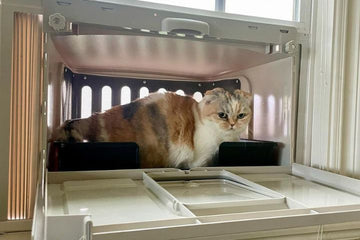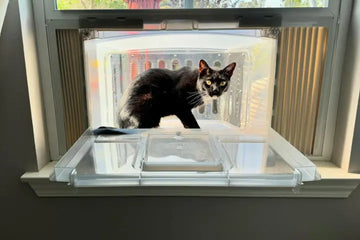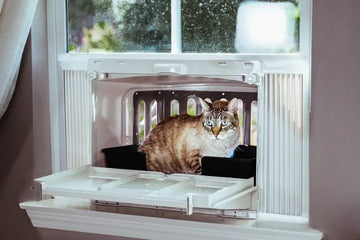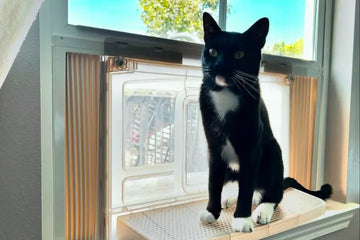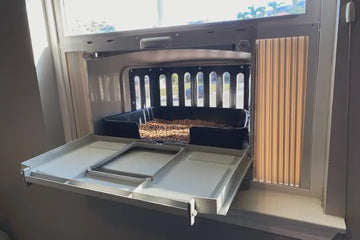Choosing the right cat litter is crucial for both the well-being of your cat and the cleanliness of your home. The type of litter not only affects how well it absorbs waste and controls odors but also influences your cat's comfort and willingness to use their cat litter box. With a multitude of options available, understanding the differences between various types of cat litter is essential. The right litter can significantly reduce maintenance efforts, control unpleasant odors, and provide a comfortable environment for your cat.
Exploring Traditional Clumping Clay Litter
Traditional clumping clay litter is renowned for its high absorbency and effective clumping properties. Made primarily from bentonite clay, it quickly absorbs liquid, forming tight clumps that are easy to scoop out. This characteristic not only simplifies cleaning but also contributes significantly to odor control cat litter. The clumps isolate waste, preventing the spread of odor and maintaining a cleaner litter box environment.
One of the reasons for the widespread popularity of clumping clay litter is its wide availability. You can find this type of litter in almost any store that sells pet supplies. Its long-standing presence in the market has made it a go-to choice for many cat owners. Besides, its affordability makes it an attractive option for those seeking a reliable and budget-friendly cat litter box solution. Many brands incorporate additional odor-controlling agents like baking soda or activated charcoal to enhance their natural odor-blocking properties. However, it's important to change the litter regularly and remove clumps daily to maintain its effectiveness in odor control and ensure it remains the best cat litter box for odor control.
While clumping clay litter is suitable for most cat breeds, there are exceptions. For instance, kittens and cats with respiratory issues might find the dust from clay litter problematic. Long-haired breeds might also carry litter particles outside the box due to their fur. Despite these considerations, for many cat owners, traditional clumping clay litter remains a top choice for its convenience and effectiveness.
Understanding Non-Clumping Clay Litter
Non-clumping clay litter is often chosen for its affordability and ease of access. Made from materials like sepiolite or attapulgite, this type of litter is less expensive than many other varieties, making it a budget-friendly option for cat owners. It’s readily available in most pet stores and supermarkets, ensuring that cat owners can easily find it when needed. For those prioritizing cost and accessibility, non-clumping clay litter can be an attractive option for their cat litter box.
When it comes to odor control, non-clumping clay litter requires more frequent changing compared to clumping varieties. While it does absorb urine, it doesn't form clumps, making it less effective at isolating odors over time. This means that while initially more affordable, the litter may need to be replaced more often, which could increase the overall cost and effort in maintaining a fresh-smelling cat litter box.
Non-clumping clay litter is best suited for cat owners who can commit to regular litter changes and who don't mind the additional maintenance. It’s also a good choice for younger kittens who might ingest clumping litter. However, its limitations in odor control and the tendency for more tracking make it less suitable for owners looking for low-maintenance, odor control cat litter. Considering these factors is essential in deciding if non-clumping clay litter is the right choice for your needs.
Advantages of Silica Gel Litter
Silica gel litter stands out for its superior odor control properties. Composed of silica dioxide sand, it effectively absorbs and locks in moisture, reducing the growth of bacteria and, consequently, the odor. This makes it an excellent choice for cat owners who prioritize a fresh-smelling cat litter box. Silica gel litter offers a range of advantages that make it an appealing choice for cat owners seeking an effective and low-maintenance option. Key points to remember about silica gel litter:
- Effective Odor Control: Rapidly absorbs and neutralizes odors.
- Low-Dust Formula: Ideal for those with respiratory sensitivities.
- Cost-Effective Over Time: Less frequent need for replacement.
- Low Maintenance: Longer intervals between litter changes.
- Healthier Environment: Reduces growth of bacteria due to high absorbency.
Choosing silica gel litter can be a wise decision for cat owners who value cleanliness, health considerations, and effective best cat litter box for odor control in their homes.
Biodegradable Litter Options
Recycled paper litter is an eco-friendly choice for cat owners. Made from post-consumer paper, this type of litter is highly absorbent and lightweight. It's also virtually dust-free, making it a good option for cats with respiratory issues. While recycled paper litter doesn't clump as clay or silica gel litters do, it's effective in controlling odors and is a great cat litter that doesn't smell. Additionally, its soft texture is gentle on cats' paws, particularly suitable for cats recovering from surgery or with sensitive feet.
Pine, wheat, and corn litters offer significant environmental benefits. These litters are made from natural, renewable resources and are completely biodegradable. Pine litter, made from compressed sawdust, releases a natural, pleasant scent, aiding in odor control cat litter. Wheat and corn litters are known for their natural clumping ability and are safe to flush in small quantities, making waste disposal easier and more environmentally friendly.
Biodegradable litters are often the best choice for cats with allergies or sensitivities, as they are free from the artificial fragrances and harsh chemicals found in some traditional litters. Their natural composition is less likely to irritate cats' respiratory systems or skin, providing a comfortable and safe litter option for sensitive felines.
Exploring Crystal Litter
Crystal litter, made primarily from silica, is renowned for its excellent odor control and high absorbency. Its unique crystal structure allows it to absorb a large amount of liquid relative to its size, effectively trapping odors in the process. A significant advantage of crystal litter is its minimal tracking. The crystal pieces are larger and less likely to stick to your cat's paws, reducing the spread of litter outside the cat litter box. This feature helps in keeping the home clean and litter-free, making it an attractive option for those who prioritize cleanliness.
Alternative Litters: Tofu and Bamboo
Tofu and bamboo litter are gaining attention for their eco-friendliness and biodegradability. Tofu litter, made from recycled tofu and soy fibers, is an excellent biodegradable option that's gentle on the environment. Bamboo litter, derived from sustainable bamboo sources, is another eco-conscious choice. Both types degrade quickly and can be composted, making them ideal for cat owners who are environmentally conscious and seeking sustainable cat litter solutions.
They are also known for their absorbency and minimal tracking properties. Tofu litter has the added benefit of being flushable, adding convenience in disposal. While they may be a new concept for some cat owners, these litters hold their own against more conventional options in controlling odors and maintaining a clean cat litter box. Transitioning cats to a new type of litter, such as tofu or bamboo, should be done gradually. Start by mixing the new litter with the old type, gradually increasing the proportion over time. This gradual transition helps cats adjust to the new texture and scent, ensuring a smooth switch to these alternative litters. For cat owners interested in eco-friendly options, tofu, and bamboo litter are worth considering as a sustainable approach to the best cat litter box for odor control.
Selecting the appropriate cat litter is a crucial decision for any cat owner. It impacts not only the cleanliness of your home but also the health and comfort of your feline friend. Throughout this guide, we've explored a variety of litter types, each with its unique benefits and considerations. From traditional clumping and non-clumping clay litters to innovative options like silica gel, biodegradable choices, and alternative litters like tofu and bamboo, the range of available options can cater to diverse needs and preferences.
Remember, what might be the best cat litter box for odor control for one cat may not be the same for another. It’s often a process of trial and error to find the perfect match. With the information provided in this guide, cat owners are well-equipped to make an informed choice, ensuring their furry companions are happy and their homes remain clean and fresh.



